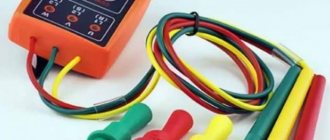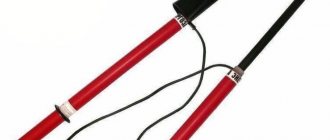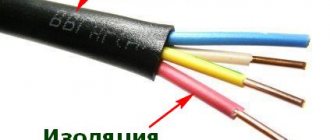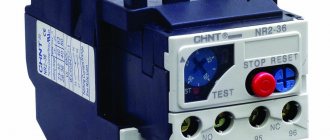DIELECTRIC GLOVES. PURPOSE AND REQUIREMENTS FOR THEM
6.2.
In electrical installations, it is allowed to use only gloves marked with the protective properties of the brand En., where En is protection against electric current with voltages up to 1000V. 6.3. The length of the glove must be at least 350 mm. The size of the gloves should allow you to wear wool or cotton gloves underneath to protect your hands from exposure to low temperatures when servicing open devices in cold weather. The width along the bottom edge of the gloves should allow them to be pulled over the sleeves of outerwear. Gloves can be five-fingered or two-fingered.
RULES FOR USE OF DIELECTRIC GLOVES
6.7. Before using gloves, check for punctures by twisting them towards your fingers.
6.8. When working with gloves, their edges should not be turned up. To protect against mechanical damage, it is allowed to wear leather or canvas gloves or mittens over the gloves.
6.9. Gloves in use should be periodically (depending on local conditions) disinfected with soda or soap solution.
6.10. Once every 6 months, gloves must be tested with an increased voltage of 6 kV for 1 minute. The current through the glove should not exceed 6 mA.
DIELECTRIC RUBBER BOOTS AND GALOSHE
1.1 Special dielectric footwear (adhesive galoshes, rubber or shaped boots, including tropical boots) is an additional electrical protective equipment when working in closed or, in the absence of precipitation, in open electrical installations. In addition, dielectric boots and galoshes protect workers from step voltage.
1.2. Footwear is used: galoshes - for voltages up to 1000 V. boots - for all voltages.
1.3. Dielectric shoes should be different in color from other rubber shoes.
1.4. Galoshes and boots consist of a rubber upper, rubber grooved sole, textile lining and internal reinforcing parts. Boots must have lapels. Uniform boots can be produced without lining. The height must be at least 160mm.
2. RULES FOR USE OF DIELECTRIC FOOTWEAR AND ITS TESTING
2.1. Before use, overshoes and boots must be inspected to detect defects (detachment of facing parts, non-tightening of the leg lining, divergence of the ends of the lining, foreign hard inclusions, protrusion of wax), the presence of a stamp and the test date.
2.2. Dielectric galoshes are tested at a voltage of 3.5 kV. and bots - voltage 15 kV for 1 minute. The test is carried out once every 6 months.
RUBBER DIELECTRIC CARPETS AND INSULATED STANDS
1.1. Rubber dielectric carpets and insulating supports are used as additional electrical protective equipment in electrical installations up to 1000 V. Carpets are used in closed electrical installations of all voltages, except for particularly damp rooms, and in open electrical installations in dry weather. The stands are used in damp and dirty areas.
1.2. Carpets are made in the following sizes.' length from 500 to 1000 mm, width from 500 to 1200 mm, thickness 6±1 mm.
1.3. Carpets must have a corrugated front surface and be one color. It is recommended to use carpets measuring at least 50x100 cm.
1.4. The insulating support consists of a flooring supported on supporting insulators with a height of at least 70 mm.
1.5. The flooring of the stand, measuring at least 500×500 mm, should be made of wooden planks without knots or cross-layers, planed from well-dried wood. The gaps between the slats should not exceed 30mm. Solid decking makes it difficult to inspect insulators.
1.6. Insulating supports must be strong and stable. To prevent the insulating stand from tipping over, the edges of the floorings should not protrude beyond the supporting surface of the insulators.
2. RULES FOR USE OF CARPETS AND STANDS.
2.1. After storage at sub-zero temperatures, carpets must be kept in packaged form at a temperature of 20±5 degrees Celsius for at least 24 hours before use.
2.2. Carpets and insulating pads must be cleaned of dirt, dried and inspected for defects before use.
3. TESTING OF CARPETS AND LITTERINGS.
3.1. Carpets and coasters are not tested for use. They are rejected during inspections. Carpets should be cleaned of dirt and inspected at least once every 6 months. If defects are detected in the form of punctures, tears, cracks, etc. they should be replaced with a new one. The supports are inspected once every 3 years to ensure that there are no violations of the integrity of the supporting insulators, kinks, or weakening of the connection between individual parts of the flooring. If these defects are detected, they are rejected. And after eliminating defects, they are tested according to acceptance testing standards.
What types of personal protective equipment are there (electrical safety)
Protective means used in electrical installations are divided into several main types depending on the voltage used, as well as basic and additional in the work, which are also defined as the method of carrying out the work.
When carrying out constant work with electrical equipment, for example, in the profession of an electrician or other work directly related to the danger of electric shock, such a set must meet all quality standards and be fully available at the enterprise.
General means of neutralizing the negative effects of electric current
Basic electrical protective equipment
The main means of protecting personnel from electric shock also have a gradation depending on work under different voltages. Accordingly, depending on the safety requirements, the requirements for the quality and composition of the materials of such instruments also differ. The main difference from additional ones is the ability to constantly carry out work activities without the need to de-energize electrical equipment.
Protective clothing used while working on installations
Up to 1000 W
When working on equipment with voltages not reaching 1000 volts, the following are used:
- special rubberized gloves made using modern polymers that can withstand high stress for a long time;
- insulating rods made using dielectric metal, which are attached to the source of electricity and serve as the main grounding conductor, resulting in safe operation;
- special pliers that can be used in places. Where the use of a barbell is not possible. These pliers are also used to carry out repair work;
- special equipment with voltage indicators for measuring current strength and voltage.
Voltage indicators used in installations up to 1000V
From 1000 W
The requirements for this category are higher, since voltage over 1000V is almost guaranteed to lead to the death of an employee as a result of receiving an electric shock:
- high voltage indicators that can show an indication of such high voltage. Such devices have powerful insulation and only show voltages above 1 kilovolt;
- high-voltage insulating rods are made of a special material that can withstand increased loads, as well as special pliers with which an electrician is able to carry out work;
Such tools should only be used in conjunction with personal protective equipment that also ensures the safety of the worker. These things include special wooden pallets that isolate electric current within a certain area. Also, during activities with high voltage, skin protection in the form of special jackets and overalls made of non-conductive material is a mandatory attribute. Eye protection against sparks is also mandatory.
Voltage meters used in installations with high voltages over 1000V
General rules for testing protective equipment
1.5. General rules for testing protective equipment
1.5.1. Acceptance, periodic and type tests are carried out at the manufacturer according to the standards given in Appendices 4 and 5, and the methods set out in the relevant standards or technical specifications.
1.5.2. In operation, protective equipment is subjected to regular and extraordinary operational tests (after a fall, repair, replacement of any parts, if there are signs of malfunction). The standards for operational tests and the timing of their implementation are given in Appendices 6 and 7.
1.5.3. Tests are carried out according to approved methods (instructions).
Mechanical tests are carried out before electrical tests.
1.5.4. All testing of protective equipment must be carried out by specially trained and certified personnel.
1.5.5. Before testing, each protective equipment must be carefully inspected to check the presence of manufacturer's markings, numbers, completeness, absence of mechanical damage, and the condition of insulating surfaces (for insulating protective equipment). If the protective equipment does not comply with the requirements of this Instruction, tests are not carried out until the identified deficiencies are eliminated.
1.5.6. Electrical tests should be carried out using alternating current at power frequency, usually at a temperature of plus (25 +/- 15) °C.
Electrical tests of insulating rods, voltage indicators, voltage indicators for checking phase coincidence, insulating and electrical clamps should begin with checking the dielectric strength of the insulation.
The rate of voltage rise to 1/3 of the test voltage can be arbitrary (a voltage equal to the specified voltage can be applied by a push); further increase in voltage should be smooth and fast, but allowing the readings of the measuring device to be read at a voltage of more than 3/4 of the test voltage. After reaching the rated value and holding at this value for a rated time, the voltage must be smoothly and quickly reduced to zero or to a value not exceeding 1/3 of the test voltage, after which the voltage is turned off.
1.5.7. The test voltage is applied to the insulating part of the protective equipment. In the absence of an appropriate voltage source for testing entire insulating rods, insulating parts of voltage indicators and voltage indicators for checking phase coincidence, etc. It is allowed to test them in parts. In this case, the insulating part is divided into sections to which a part of the normalized full test voltage is applied, proportional to the length of the section and increased by 20%.
1.5.8. Basic insulating electrical protective equipment intended for electrical installations with voltages above 1 to 35 kV inclusive are tested with a voltage equal to 3 times the linear voltage, but not lower than 40 kV, and those intended for electrical installations with voltages of 110 kV and above - equal to 3 times the phase voltage.
Additional insulating electrical protective equipment is tested by voltage according to the standards specified in Appendices 5 and 7.
1.5.9. The duration of application of the full test voltage is usually 1 min. for insulating protective equipment up to 1000 V and for insulation made of elastic materials and porcelain and 5 min. — for insulation from layered dielectrics.
For specific protective equipment and working parts, the duration of application of the test voltage is given in Appendices 5 and 7.
1.5.10. Currents flowing through the insulation of products are standardized for electrical protective equipment made of rubber and elastic polymer materials and insulating devices for live work. Operating currents flowing through voltage indicators up to 1000 V are also standardized.
Current values are given in Appendices 5 and 7.
1.5.11. Breakdown, flashover, and surface discharges are determined by turning off the testing facility during testing, by readings from measuring instruments, and visually.
1.5.12. Electrical protective equipment made of solid materials should be checked by touch immediately after testing for the absence of local heating due to dielectric losses.
1.5.13. If a breakdown, flashover or surface discharge occurs, the current through the product increases above the rated value, or local heating occurs, the protective equipment is rejected.
1.4. Accounting for protective equipment and monitoring their condition 1.4. Accounting for protective equipment and monitoring their condition
2. ELECTRICAL PROTECTIVE EQUIPMENT2. ELECTRICAL PROTECTIVE EQUIPMENT >>>
ATTENTION! LECTURE SITE.ORG is conducting a weekly survey. TAKE PART. ONLY 1 MINUTE!!!
⇐ Previous3Next ⇒
The main insulating electrical protective agent is an insulating electrical protective agent, the insulation of which can withstand the operating voltage of the electrical installation for a long time and which allows working on live parts that are energized.
An additional insulating electrical protective agent is an insulating electrical protective agent, which in itself cannot provide protection against electric shock at a given voltage, but complements the main means of protection, and also serves as protection against touch voltage and step voltage.
The main insulating electrical protective equipment for electrical installations with voltages over 1000V include:
— insulating rods of all types;
- insulating pliers;
— voltage indicators;
— devices and devices to ensure the safety of work during measurements and tests in electrical installations (voltage indicators for checking phase coincidence, electrical clamps, devices for puncturing cables, etc.);
- special protective equipment, insulating devices and devices for work under voltage in electrical installations with voltages of 110 kV and above (except for rods for transferring and equalizing potential)
Additional insulating electrical protective equipment for electrical installations with voltages over 1000V include:
— dielectric gloves and boots;
— dielectric carpets and insulating supports;
— insulating caps and linings;
— rods for transferring and leveling potential;
— ladders, insulating fiberglass stepladders.
The main insulating electrical protective equipment for electrical installations with voltages up to 1000V include:
— insulating rods of all types;
- insulating pliers;
— voltage indicators;
— electrical clamps;
— dielectric gloves;
- hand-held insulating tool,
Additional insulating electrical protective equipment for electrical installations with voltages up to 1000V include:
— dielectric galoshes;
— dielectric carpets and insulating supports;
— insulating caps, coverings and linings;
— ladders, insulating fiberglass stepladders.
6 Fire safety requirements for the operation of electrical receivers and electrical installation products.
1.4.4. When operating existing electrical installations, it is prohibited:
use electrical energy receivers (power receivers) in conditions that do not comply with the requirements of the manufacturer’s instructions, or have faults that, in accordance with the operating instructions, can lead to a fire, as well as operate electrical wires and cables with damaged insulation or loss of protective properties;
use damaged sockets, switches, and other electrical installation products;
wrap electric lamps and lamps with paper, cloth and other flammable materials, as well as operate lamps with removed caps (diffusers) provided for by the design of the lamp;
use electric irons, electric stoves, electric kettles and other electric heating devices that do not have thermal protection devices, without stands made of non-flammable heat-insulating materials that eliminate the risk of fire;
use non-standard (homemade) electric heating devices, use uncalibrated fuse links or other homemade overload and short circuit protection devices;
place (store) flammable (including flammable) substances and materials near electrical panels, electric motors and starting equipment.
1.4.7. It is prohibited to operate electric heating devices if the thermostats provided for by the design are missing or malfunctioning.
1.4.2. Electrical installations and household electrical appliances in premises where there is no staff on duty at the end of working hours must be de-energized. Emergency lighting, fire extinguishing and fire water supply installations, fire and fire alarm systems must remain energized. Other electrical installations and electrical products (including in residential premises) may remain energized if this is due to their functional purpose and (or) provided for by the requirements of the operating instructions.
⇐ Previous3Next ⇒
Date added: 2016-12-05; | Copyright infringement | Sayings for students
Additional electrical protective equipment
Let's move on to consider auxiliary protective equipment in electrical installations, which, like the main ones, are usually divided by voltage class
Please note that with the main means of protection in electrical installations up to 1000V, it is allowed to use only one additional means of protection, if this does not contradict production factors or technical requirements
Up to 1000 V
Isolating devices of this group include:
- Safety shoes in the form of dielectric galoshes or rubber boots. With the help of such products it is possible to avoid exposure to electric currents connected to the ground. It is recommended to use if the floor in the work area has a conductive coating.
- Insulating stands and dielectric carpets. The purpose of this PPE is the same as that of safety shoes. The use of carpets and stands is allowed in closed spaces (except for damp rooms) and in open spaces (in dry weather).
- A variety of insulating linings and caps. They physically prevent accidental switching on of the line on which technical work is being carried out.
Above 1000 V
High voltage auxiliaries include:
- Safety shoes and gloves with appropriate dielectric characteristics.
- Safety helmets, specialized suits, etc.
- Portable grounding and fencing of live parts.
It is typical that when working in high-voltage installations with basic protective equipment, several types of auxiliary personal protective equipment are used.
Additional
Additional devices and protective equipment include:
Dielectric gloves. Protect worker's hands from electric current
Please note that in the list of electrical protective equipment used in electrical installations up to 1000 Volts, gloves belong to the main set of protective devices, and not an additional one (according to the same RD 34.03.603).
Dielectric bots. They are used to completely protect the electrician from the foundation underneath.
Rubber mat
Like bots, it isolates working personnel from the ground.
Insulating stand. When operating at voltages above 1000 V, it must be equipped with porcelain insulators.
Insulating linings and caps. They prevent short circuits and are also an electrical protective device.
Extension ladders and stepladders made of fiberglass.
Bars for leveling and transferring potential. They are used to transfer the dangerous potential of an overhead line to the place where the electrician is working.
After reading the article, we recommend that you watch this video:
So we have listed all electrical protective equipment in electrical installations above 1000 Volts. Please note that the listed devices must be checked before starting work, and also tested under voltage. We will tell you about this in our new publications!
We recommend reading:
- Tests on labor protection during the operation of electrical installations
- How to make an electrode boiler from improvised materials
- Electrical safety signs and posters
Sad statistics
According to statistics, up to 30,000 people die from electric shock every year. Most often, the causes of electrical injuries are ignorance of the mechanism of physiological effects of electric current on the human body, violation of current rules and instructions on occupational safety and non-use of personal protective equipment.
The consequences of possible injury from direct electric current can be different - from quite mild to very sad, for example:
- convulsive muscle contraction without loss of consciousness;
- convulsive muscle contraction with loss of consciousness, but with preserved breathing and heart function;
- loss of consciousness and disturbances in cardiac activity or breathing (or both);
- clinical death, that is, lack of breathing and blood circulation.
The following components influence the outcome of an electric shock:
- the duration of passage of electric current through the human body;
- frequency and type of current;
- physiological characteristics of a person;
- resistance to stress;
- voltage value.
Every employer must make every effort to eliminate the causes of electrical injuries at the enterprise. First of all, this is facilitated by the training of personnel servicing electrical installations and the use of the necessary PPE. By the way, the employer must provide personal protective equipment to employees completely free of charge when working in electrical installations.
Requirements for certain types
The general set of protective equipment according to the PUE includes not only special equipment, but also a special current tool. Its main purpose is to protect a person working in electrical networks from direct contact with high potential. There are a number of special requirements for specific types of protective equipment of any type, listed below:
- The individual items included in the equipment (rubber gloves, for example, as well as rubberized shoes and other things) are kept in perfectly clean condition. Only in this case are they able to perform their functions, which consist in reliably isolating the human body from open conductive parts of electrical equipment.
- Protective devices with grip handles (they are used when working in electrical installations with any voltage) must have restrictive rings on their holders.
- With the tool, he grasps the handles only in areas located up to the restrictive ring.
The last requirement is due to the fact that the standards define the maximum permissible gap to live parts, which is considered safe. In this case, special attention is paid to the insulated part of the holder, the length of which is made sufficient to provide guaranteed protection against electric shock.
All products used in servicing power supply systems are designed to operate in a given voltage range. As a rule, this parameter is marked on the body of the instrument or in a special place in the protective equipment. The PUE separately stipulates that its real value often differs from the declared nominal value, so you should focus on the value taken with a small margin.
INSPECTION AND TESTING OF BELTS, CARABINES, ROPES OF GAS MASKS TYPE PSH-1, PSH-2
2. Testing of life belts is not allowed if the following defects are present:
2.1. Damage (tear or cut of any size) to the waistband or shoulder straps.
2.2. Damage to the fastening straps.
2.3. Buckle malfunction.
2.4. No washers on the rivets.
2.5. Rivet slot for the waist band of straps or belts.
2.6. The presence of looseness or protrusions in the place where the valves are hinged.
2.7. Weak carbine bolt springs.
3. Rescue belts, carabiners and ropes are subjected to periodic strength testing with a statistical load of 200 kg twice a year.
4. When testing a rescue belt, a load is attached to the ring of this belt, fastened with buckles and suspended on both straps, under which the belt remains for 5 minutes. The test is considered successful if, after removing the load, there is no damage to the belt.
5. A carbine suspended by the eye with the bolt open is tested under the same load for 5 minutes. The carbine is considered to have passed the test if, after removing the load, its shape and dimensions do not change, and if the released carbine bolt freely returns to its place.
6. The rescue rope is tested by suspending a 200 kg test load for 15 minutes. The residual elongation of the rope, determined by measuring its length before and after the test, should not exceed 5° of the original length.
After testing, the rope is inspected and there should be no damage to it.
7. The test results of the rescue belt and rope are recorded in a special journal or documented in a report, and a tag indicating the belt number, static load and the date of the next test is attached to the belt and rope.
HOSE GAS MASKS TYPE PSh-1 and PSh-2
4.2. A hose gas mask completely isolates the human respiratory system from the surrounding atmosphere from any gas, steam, smoke.
4.3. Hose gas masks come in self-priming type PSh-1 and with forced air supply PSh-2.
4.4. Hose gas mask PSh-1 has the following components:
- A mask with two corrugated tubes connected in series.
10 m long hose for suctioning clean air.
Belt for attaching a hose and attaching a rescue rope.
A pin with which one end of the hose is secured in the clean air zone.
Filter box for cleaning inhaled air from dust.
A suitcase for storing and carrying gas mask parts.
4.6. Hose gas mask type PSh-2 includes the following elements:
- Electric motor for rotating the blower.
Blower with two fittings for supplying air to hoses with manual or electric drive.
Two hoses up to 20 m each, through which air is supplied under the masks.
Two masks with elongated corrugated tubes connecting the masks to the hoses.
Box in which the electric motor and blower are installed.
4.8. When performing work in oil tanks, wells, cisterns and other confined places, each worker must be served by two people. One provides the air supply, the other holds the signal rope and assists the worker if necessary.
4.9. Over the overalls, the worker must wear a safety belt, to the straps of which a signal-rescue rope is attached. The end of the signal rope brought out must have a length of at least 5 meters.
4.10. The rescue rope and rescue belt must be tested for strength, as they serve as a means of communication between the person working in a gas mask and his assistant, as well as for removing the worker from the area in the event of an accident. A hose can also be used for rescue. All its connections are made strong, capable of withstanding the load when a person is pulled out.
4.11. If there is no conditional response from the worker to the signals of the observers, they must immediately remove him from the zone.
4.12. Preparation for entering the gas-contaminated area must necessarily take place with the participation of the work manager (foreman, site manager) and consist of the following:
- A thorough inspection of the hose, corrugated tube and mask.
To check the strength and reliability of the connection of all parts of the gas mask.
Blowing out dust from the hose. Blowing is done with compressed air or several outlets from the end to which the corrugated tube is screwed. Before purging, the filter box is turned off.
4.14. When using a PSh gas mask, a worker can enter a gas-contaminated area to carry out work only after he has made sure that fresh air is supplied under the mask in an amount sufficient for normal breathing.
4.15. The duration of continuous work in a hose gas mask should not exceed 30 minutes. followed by rest in clean air for at least 15 minutes.
16. After finishing work, all parts of the gas mask are cleaned of dirt and dust and placed in a suitcase until next use.
4.17. The person responsible for the good condition of gas masks must check the serviceability of gas masks at least once every three months and note the result of the check in the “Hose Gas Masks Test Log.”
Logbook for testing and inspection of hose gas masks PSH-1. PSh-2
| date | Result of checking | Signature |
Note: When checking, pay special attention to the working condition of the mask, hose, rescue belt and rope and forced air supply device
I. SAFETY HELMETS
General purpose safety helmets
Hard shell made of high-strength polyethylene or polycarbonate. Weight up to 300 gr. Headband made of textile or plastic tapes with 4 - 6 attachment points. Easy adjustment to fit head size. The helmet must have:
- adjustable strap for proper attachment to the head;
sufficient head space for ventilation;
pockets for attaching glasses, headphones, shields;
The guaranteed shelf life of a helmet is the total period of storage and use. It is counted from the date of manufacture, which is marked on the inside of the visor.
ATTENTION: It is prohibited to perform any work with technological equipment or hand tools, or to be near such work without protective helmets!
1.3. Mandatory certification for compliance with GOST 12.4.128-83 and EN 397.
1.4. Manufacturers: Technoavaia, Uvex. 3M, Sacla, MSA Auer, etc.
1.5. Work using safety helmets:
- Work in areas marked with “Compulsory wearing of a helmet” signs.
Maintenance of technological equipment.
Lifting operations and movement of goods.
Construction works.
Warehouse work.
Work in areas where molten materials and chemicals may splash.
Work in the area of possible contact of the head with electrical wiring.
If there is a risk of head contact with low-lying structural elements.
Helmets are replaced in accordance with the manufacturers' recommendations, namely:
- After the expiration of the warranty period specified in the instructions for the helmet.
In case of damage or strong impact.
If the headband support band is damaged.
- Store protective helmets in dry rooms at temperatures up to +20C0, away from heating devices, avoiding direct sunlight (including near the rear window of the car)
Clean all plastic parts with aqueous cleaning solutions.
- Use helmets whose warranty period has expired.
Use helmets without headbands.
Modify the helmet shell or headband.
Carry any objects inside the helmet.
Paint helmets or remove marking stickers.
Dropping or throwing helmets, using them as stands, or using helmets for purposes other than their intended purpose.
Wear a helmet with the visor facing backwards.
- The industry produces helmets in six colors: white, blue, red, orange, yellow and brown.
White helmets are for management personnel of organizations and enterprises, heads of sections and workshops, public labor safety inspectors and safety officers.
Red helmets - for foremen, foremen, engineering and technical workers, chief mechanics and chief power engineers
Yellow and orange helmets are for workers and junior service personnel.
1-54-58cm; II - 58-62 cm.
Latest documents in the Database
Occupational Safety and Health
Order on exemption from on-the-job training
On-the-job training program for storekeeper
Order on the employee’s permission to work
Order on internship for a newly hired employee
Fire safety
Order on the creation of a fire-technical commission
Work plan of the fire-technical commission
Fire protection systems maintenance schedule plan
Fire evacuation plan text part
electrical safety
Order on the creation of a commission on electrical safety
Order for assignment of 1st electrical safety clearance group
Order on the appointment of a person responsible for electrical equipment
Training program group 3 on electrical safety
Procedure for using protective equipment
According to the current Rules, PPE, as inventory property, must be stored in premises designated for this purpose and issued to field teams or for individual use.
Only those protective equipment in electrical installations that have passed tests are allowed for use, and there is a corresponding entry on the product stamp.
As for the norms of distribution, they depend on internal regulations, which take into account the characteristic conditions in a particular organization. But at the same time, violations of the requirements of safety and labor protection standards are not allowed. When distributing, information about storage locations is required to be retained. For this purpose, special lists are provided, recorded with the signature of the responsible person and the seal of the organization.
If during the testing process or during an external inspection unsuitable personal protective equipment is identified, they are subject to write-off, followed by removal from the storage location. Information about this should be reflected in the protective equipment record book or operational documents, for example, when the unsuitability of personal protective equipment is discovered on the road.
Electrical personnel, after receiving PPE in hand, bears full responsibility for compliance with operating rules and must be able to independently determine their current condition, as far as possible under working conditions. In this case we are talking about external inspection for integrity.
Protective equipment in electrical installations intended for enclosed spaces can be used in open spaces, but only if the weather is dry. In case of frost, rain or high humidity, it is necessary to use specialized tools designed for use in such weather conditions. A note on the relevant electrical tests must be included in the product passport.
Before starting to operate PPE, electrical personnel are required to check for any punctures in the insulation or other damage. It is mandatory to check the permissible service life and the date of the last tests. This information is contained in the stamp. It is strictly prohibited to use expired protective equipment during work!
To avoid exposure to touch voltage, do not touch the working surfaces of PPE during operation, as well as insulating parts outside the limiting stop or ring.
General rules of use
The procedure for using electrical protective equipment and equipment is described in detail in the regulatory documentation regarding compliance with safe work practices in installations and switchboards. The requirements of the PUE provide for the following rules for their use:
If it is necessary to work with specific equipment, first of all, its serviceability (suitability for use) is carefully checked.
- You should carefully examine the appearance of the protective equipment. It is not allowed to contain any contamination or damage to the housing.
- A mandatory requirement is the inadmissibility of using rubber products that are not dry enough (with traces of liquid leakage, for example). They are not recommended for use in winter frost and during rainfall.
- Any protective equipment must have a test mark indicating the date of the next tests.
If at least one of these points is violated, the existing equipment is unsuitable for use, since when working with it, a person may be accidentally injured. According to current regulations, it is removed from the kit for the purpose of troubleshooting or unscheduled testing.
When planning work operations and operational switching in rooms with high humidity levels, rubber protective products designed specifically for these purposes are allowed to be used.
Barbells
Purpose – operations with electrical equipment (arresters, disconnectors, fuses, etc.), freeing victims from electric current.
General view of the rod for working with electrical equipment
Requirements for devices are presented in current state standards.
The products consist of three parts: a handle, an insulating part and a working part. It is possible to assemble several copies to lengthen the overall structure.
Operating rods are made with detachable heads (to perform several types of operations).
No mechanical check required. Rods are subjected to increased stress on individual parts (heads, insulating elements). Voltage is applied between the insulated and working parts.
Operating rules:
- before commissioning, the threaded connection of individual parts of the rod is checked by screwing and unscrewing;
- The rods are not specifically grounded. Grounding is carried out in certain cases, when required by the operating instructions;
- horizontal and vertical movements of workers with barbells in their hands are prohibited;
- When working on objects above 1 kV, it is necessary to use dielectric gloves.
Requirements
To a hand-held insulated tool
The tool includes the following elements:
- screwdrivers;
- pliers;
- pliers;
- wire cutters;
- keys;
- assembler's knives.
This tool can be made in two versions:
- made of conductive material, wholly or partially covered with insulating material;
- made of insulating material with metal inserts.
The purchased tool must be checked for compliance with the following requirements:
- the insulating layer must be permanent and made of durable, moisture-resistant material;
- the insulation of the screwdriver shaft should end no closer than 10 mm from the end of its tip;
- pliers, wire cutters and pliers on the handles must have stops of at least 5-10 mm;
- For assembly knives, the insulating handle must be at least 10 cm. On the side of the working part of the knife there must be a stop of at least 5 mm.
To dielectric gloves
Gloves can be seamless, with a seam, three-fingered or five-fingered. Their length should be about 350 mm, the size should allow gloves to be put on fabric mittens, and the width should allow them to be pulled over the sleeves of clothing.
When purchasing gloves, you must check them for mechanical damage and contamination, as well as for punctures.
To safety shoes
Special footwear includes boots and galoshes. Galoshes are used when working in networks up to 1000 V, and bots are used in any networks. Safety shoes should consist of a rubber upper, grooved sole and textile lining. Boots must be at least 160 mm high, and, in addition, they must have cuffs.
Procedure for providing workers with PPE
The acquisition process, issuance procedure, rules for use and storage, as well as care for personal protective equipment and safety footwear. Standard standards for issuing PPE. Development of a list of personal protective equipment at the enterprise. Personal cards for recording the issuance of PPE. PPE on duty. Use of personal protective equipment.
***
One of the main standards that define the requirements for the acquisition process, the issuance procedure, the rules for use and storage, as well as the care of PPE, are the Intersectoral Rules for Providing Workers with Work Clothing, Safety Footwear and other PPE, approved by Order of the Ministry of Health and Social Development of Russia dated June 1, 2009 No. 290n.
Workers are provided with PPE in accordance with the standard standards for the free provision of workwear, safety footwear and other personal protective equipment.
There are quite a large number of these norms (about 70), we will not list them all. They are designed for industries or even individual holdings. They are easy to find on the Internet:
For example, .
From all the variety, we need to choose those that are suitable specifically for our production.
In the absence of professions and positions in the relevant standard standards, the employer issues to employees PPE provided for by the standard standards for workers of cross-cutting professions and positions in all sectors of the economy, and in the absence of professions and positions in these standard standards - by the standard standards for workers whose professions (positions) are typical for work performed.
Based on standard issuance standards, the occupational safety specialist develops his own list of PPE.
list of personal protective equipment
Now you need to purchase protective equipment. Purchased PPE must have certificates of conformity or declarations of conformity. Do not purchase PPE for which the certificate or declaration expires. In fact, this will mean that you are using non-certified personal protective equipment.
The procedure for issuing PPE is determined by the relevant regulations.
Regulations on the organization of the issuance and use of special clothing, special footwear and other
personal protective equipment
The issuance and return of PPE is recorded in the employee’s personal card.
Download the form of a personal registration card for the issuance of personal protective equipment
Since 2015, it has been possible to keep records of the issuance of personal protective equipment in electronic form or using special software, but this implies additional requirements for the personification of workers. Which, in our opinion, makes this norm actually stillborn.
PPE issued to workers must be appropriate for their gender, height and size.
The period of wearing PPE is calculated from the day it is issued to the employee.
Workers combining professions are additionally provided with appropriate PPE.
Employees of third-party organizations, when performing work in production shops and areas where there are harmful and (or) hazardous production factors that can affect workers, must be provided with PPE by their employer in accordance with the standard standards provided for employees of relevant professions and positions of the organization, to which they are sent.
PPE on duty
There are protective equipment needs that arise only when carrying out a certain type of work. Such PPE is assigned to certain areas or workplaces and is transferred from shift to shift.
Duty PPE is issued to managers responsible for carrying out these works.
Example. Duty means of protection against electric shock in the switchgear in accordance with the standards for acquisition according to SO 153-34.03.603-2003.
Procedure for using PPE
In addition to the fact that workers must be provided with protective equipment, the employer’s task is to properly instruct workers on how to use them correctly
It is equally important that workers do not forget to use them while performing work. Responsibility for the correct use of PPE lies with the immediate supervisor of the work
Workers must not only be able to put on PPE correctly, but also be able to determine whether it is unsuitable for use.
In addition to inspection before use, protective equipment such as those used against electric shock must undergo periodic verification.
| Dielectric gloves | Before use | Once every 6 months |
| Tool (for insulation) | Before use | Once a year |
| Direction signs (UNN) | Before use | Once a year |
| Insulating pliers | Once a year | Once every 2 years |
Recommendations before using electrical protective equipment
The recommendations that must be contained in the local regulations of an enterprise or organization in the case of work on electrical installations include:
- Before starting work, each employee is required to undergo special training on the use of protective equipment against electric shock;
- in a special briefing log there must be a note indicating that the employee has completed these activities, secured by the signature of the responsible occupational safety specialist in the organization;
- Also, the responsible specialist must check the condition of protective equipment to ensure compliance with the expiration date, integrity of the instrument, and absence of damage to these items;
- Before starting the activities, it is necessary to check the integrity of the equipment, its serviceability or the presence of certain damages that need to be repaired or that could lead to an emergency.
Note! All activities preceding work with electrical devices must be reflected in writing in the regulations of the organization
Special clothing used when working in installations









